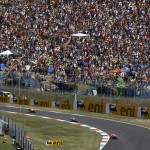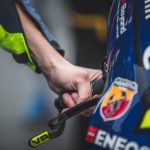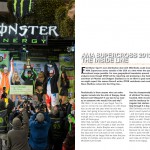Pushing through the double doors of the modest Tucker Rocky building in Irvine, California a cluttered, busy and colourful office environment hits us. Sketches, diagrams, schematics, poster art and hundreds of samples of riding gear line the walls and desks. The proverbial ‘grenade in a paint factory’ effect comes to mind. It is smaller than we thought. “We have a pretty small staff with basically two designers and a production gear responsible, and we are slowly-but-surely getting the staff roster up to where it needs to be,” comments Brand Manager and former racer Randy Valade.
The late David Bowie’s back catalogue is getting a dedicatory airing on a sound system somewhere and computer screens contain artwork for adverts and riding apparel that might not see the light of day or public view for another eighteen months. Sister brand MSR is in the same office space as is reverential handlebar manufacturer Pro Taper. We’re in the midst of a nerve centre that serves many thousands of riders, teams, OEMs and penetrates the many levels of dirt bike and motorcycle riding. It is a rare look inside how the gear on the shelves comes-to-be.
We’ve often thought that Answer – now celebrating their fortieth anniversary – is a lively addition to the clothing/product segment. The association with James Stewart at the turn of the decade was a major boost for a brand that has always appeared to take their styling and visuals very seriously. They seemed an ideal target for trying to understand how a company arrives at the liveries and schemes for often outlandish and complicated motocross kit. Also, how to appeal to a customer that can literally ‘get lost’ among the thousands of racks and hangers at a cavernous dealership like Chaparral.
“Answer focuses on the younger crowds,” says Valade. “We use bold, new colours and chase that demographic group from the young kids to the mid-twenties. We are heavily focussed on racing and not so worried about off-road because we have a MSR for that. It is all about racing for us, it is an ‘image’ brand with good marketing.”
In the same way that KTM enjoy an advantage over ‘larger’ manufacturers with their compact logistics and rapid turnaround and decision-making, it seems that Answer and parent company Tucker Rocky can also keep the ball in motion and spin it to their will. “The lines are coming along and we are pretty wide-open all the time so expanding on the gear we have now is pretty tough,” Valade continues. “I grew up racing so I know what a pant should fit like and what fabrics and technologies are out there. Right now we are working on some new stuff that should be pretty good in the future. It is probably a year out – a new high-end pant and jersey – that are fully in the works and I have not seen anybody else using the same technologies that we have and we’ll be the first on the market.”
It is a strong statement, and it is easy to feel the busy intent in Irvine. Answer are also slightly different through being a U.S. name that are seeking international growth. They backed Suzuki factory rider Kevin Strijbos in 2014 and ’15 and MX2 GP winner Max Anstie last year. This time they will have the Monster Energy DRT Kawasaki crew with Tommy Searle and Vsevolod Brylyakov in Grand Prix. Valade: “It is tough to spread internationally but, honestly, it is one of the few places we can grow because the market is pretty saturated here in the U.S. – as it is in Europe – but I think there is potential. We do well in Australia as well and sponsor the Serco team which is also a big distributor and we move a lot of product to those guys.”
Randy’s views on athlete endorsement and how Answer use a top Pro racer like Dean Wilson were interesting to hear – check out the interview at the end of the article – but for glimpses into how they fashion their wares we were introduced to Kris Guillory, who has been at the pencils and tools as a graphic designer and artist for the brand for seven years now. “Mostly on products, that range from gloves to helmets to race gear. Also print, anything that encompasses the Answer name,” he says. “It is really busy and really fun. I think I am a bit of a custodian because there are not that many designers here. We have more than our fair share in the look and the feel in different outlets and sets of gear, and themes within ‘gear’ like protection. We have our influences across the board.”
“Our work starts with the aesthetic and then goes beyond because we are a small group,” he adds. “We have been able to crossover and get into the technical side and that has been awesome. We have to have the gear looking good but just as importantly it has to fit and function.”
With ‘Jean Genie’ appropriately playing in the background Kris removes some conifential drawings that cannot be a part of Ray Archer’s photo spread and tries to breakdown his role…
OK, so how often are you refreshing the lines? What’s the time scale?
We try to come up with fresh looks as often as we can. It could be every six months or every three depending on whether we do a Springtime release. You are always trying to stay on the cusp of what is out there and that goes for a lot of sports in general. You always want a fresh new colour or a certain fabric that performs and brings ‘the game’ up a little bit; you want to be on top of all that.
So ‘getting out there’ is important for finding influences and inspiration? Even knowledge?
You gotta look at what is out there and I mean all sports: Soccer, Football [NFL]; you name it. There are so many cool-looking graphics and cool performing products or materials. I think you can see a big evolution over the last few years and that goes for motocross and with us especially. Things have to fit better, they have to be lighter and more comfortable because the bikes are now so good and so light. Going out and seeing what people are doing with fabrics, colours and techniques and mixing it with what you find online is crucial.
Read the rest of the story in the latest issue of OTOR by clicking HERE








